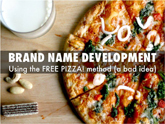What Can A Magician Teach Us About Branding?
Almost everyone loves a good magician. The magician’s sleight of hand technique in making a coin or playing card disappear delights us, as we usually take pleasure in being fooled in this manner. Once fooled, our brain rapidly kicks into gear and tries to figure out how he or she did the trick. Sometimes you figure it out, and then you get even greater pleasure. But even when you can’t figure it out, you are amazed!
Magic tricks only work if two things occur. First, the magician must divert your attention away from where the actual trick is happening, and second, your brain must fill in any missing information by combining what you already know with whatever you perceive at that very moment.
The science behind this “filling in process” by the brain is fascinating (read the Discover magazine article referenced at the end of this post). The sub-headline of the article says it all… “The eye and brain work in a partnership to interpret conflicting signals from the outside world. Ultimately, we see whatever our brains think we should.”
Truth be told, the magician is not creating the illusion–your brain is creating the illusion that something has happened (when in reality the magician has done something else). Using this technique from magic can lead to powerful branding.
This “filling in” process has been shown in numerous studies to be important to generating lasting recall and favorable persuasion. If the person’s brain is engaged and filling in the gaps, then the person will remember the experience and be favorable towards it.
Let’s say you want to name a new product (or it could be a service or a company or something else). A strong name for this product would give the consumer enough information about the product so that the consumer’s brain is engaged and starts to fill in the missing information, just as it would if you were viewing a magic trick. This was validated in a study in The Journal of Consumer Research in 2005 where the investigators looked at differences in names for crayons. The findings indicate that consumers preferred “slightly ambiguous” names such as “Blue Haze” or “Alpine Snow” to plain descriptive names such as “Blue” or “White” because the engagement of the brain with a slightly ambiguous name causes the brain tries to complete the “puzzle,” which leads to stronger recall and persuasion.
A great brand name will provide some sense of perspective to the target customer and the product itself, but it won’t provide the whole story. A great name leaves enough to the imagination so your brain gets engaged in the product/name combination and makes you curious about a product and willing to investigate it further. Just as a magician would tantalize your brain with enough “facts” and cause your brain to “fill in” the rest of the story, a great brand name is magical.
http://discovermagazine.com/1993/jun/thevisionthingma227



